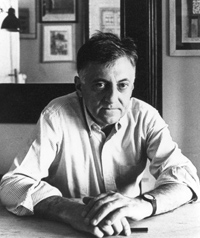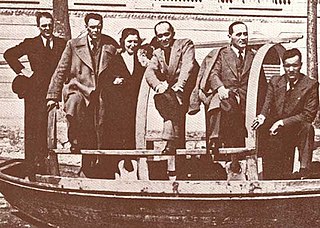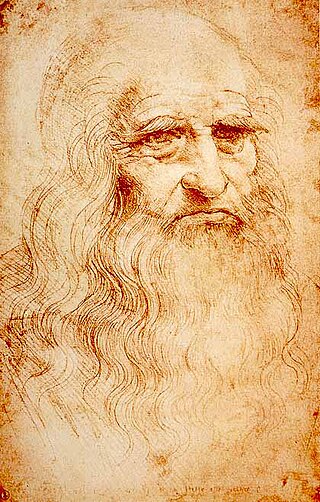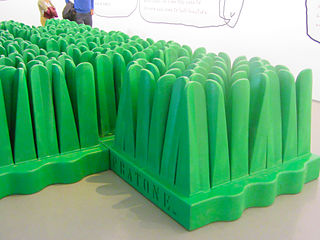
Aldo Rossi was an Italian architect and designer who achieved international recognition in four distinct areas: architectural theory, drawing and design and also product design. He was one of the leading proponents of the postmodern movement.
Juan Downey was a Chilean artist who was a pioneer in the fields of video art and interactive art.

Ettore Sottsass was a 20th-century Italian architect, noted for also designing furniture, jewellery, glass, lighting, home and office wares, as well as numerous buildings and interiors — often defined by bold colours.

Olivetti S.p.A. is an Italian manufacturer of computers, tablets, smartphones, printers and other such business products as calculators and fax machines. Headquartered in Ivrea, in the Metropolitan City of Turin, the company has been part of the Telecom Italia Group since 2003.

Mario Bellini is an Italian architect and designer. After graduating from the Polytechnic University of Milan in 1959, Bellini pursued a career as an architect, exhibition designer, product designer, and furniture designer during the Italian economic boom of the late 20th century. Bellini has received several accolades in a variety of design fields, including eight Compasso d'Oro awards and the Gold Medal for Lifetime Achievement by the Triennale di Milano. In 2019, the Italian President of the Chamber of Deputies, Roberto Fico, awarded Bellini a career medal in recognition of his contributions to Italian architecture and design.

Cesare Colombo, known as Joe Colombo, was an Italian industrial designer.

Bruno Munari was "one of the greatest actors of 20th-century art, design and graphics". He was an Italian artist, designer, and inventor who contributed fundamentals to many fields of visual arts in modernism, futurism, and concrete art, and in non-visual arts with his research on games, didactic method, movement, tactile learning, kinesthetic learning, and creativity. On the utility of art, Munari once said, "Art shall not be separated from life: things that are good to look at, and bad to be used, should not exist".

The Sacco chair, also known as a bean bag chair,beanbag chair, or simply a beanbag, is a large fabric bag filled with polystyrene beans. It was designed by Piero Gatti, Cesare Paolini and Franco Teodoro in 1968. "Sacco" is Italian for "bag" or "sack". The product is an example of an anatomic chair as the shape of the object is set by the user.

Gaetano Pesce was an Italian architect and a design pioneer of the 20th century. Pesce was born in La Spezia in 1939, and he grew up in Padua and Florence. During his 50-year career, Pesce worked as an architect, urban planner, and industrial designer. His outlook is considered broad and humanistic, and his work is characterized by an inventive use of color and materials, asserting connections between the individual and society, through art, architecture, and design to reappraise mid-twentieth-century modern life.

Achille Castiglioni was an Italian architect and designer of furniture, lighting, radiograms and other objects. As a professor of design, he advised his students "If you are not curious, forget it. If you are not interested in others, what they do and how they act, then being a designer is not the right job for you."

Brionvega is an Italian electronics company that is known for manufacturing futuristic television sets and audio equipment, its contributions to post-second world war technological and social advancement in Italian industry, collaborations with well known industrial designers and architects, and its impact on the aesthetics of 1960s Italian design.

Marcello Nizzoli was an Italian artist, architect, industrial and graphic designer. He was the chief designer for Olivetti for many years and was responsible notably for the iconic Lettera 22 portable typewriters in 1950.

The Olivetti Programma 101, also known as Perottina or P101, is one of the first "all in one" commercial desktop programmable calculators, although not the first. Produced by Italian manufacturer Olivetti, based in Ivrea, Piedmont, and invented by the Italian engineer Pier Giorgio Perotto, the P101 used many features of large computers of that period. It was launched at the 1964 New York World's Fair; volume production started in 1965. A futuristic design for its time, the Programma 101 was priced at $3,200 (equivalent to $30,900 in 2023). About 44,000 units were sold, primarily in the US.

Science and technology in Italy has a long presence, from the Roman era and the Renaissance. Through the centuries, it has made many significant inventions and discoveries in biology, physics, chemistry, mathematics, astronomy, and other sciences. In 2019, Italy was the world's sixth-highest producer of scientific articles, publishing more than 155,000 documents. From 1996 to 2000, it published two million. It ranked 28th in the Global Innovation Index for 2022.

Gufram is an Italian furniture manufacturer known for avant-garde, conceptual, witty, and Pop-art influenced designs; the unconventional use of industrial materials; collaborations with well known architects and designers; and the contribution its products made to the aesthetics of the 1960s Radical period of Italian design.

Pier Giorgio Perotto was an Italian electrical engineer and inventor. Working for the manufacturer Olivetti, he led a design team that built the Programma 101, one of the world's first programmable calculators.

Sergio Asti was an Italian designer and architect, primarily known for his industrial designs for firms such as Artemide, Brionvega, FontanaArte, Gabbianelli, Heller, Knoll, Salviati, and Zanotta.

Eugenio Gerli was an Italian architect and designer. In an intense working life spanning more than six decades, Eugenio Gerli explored many different areas of his profession. He built villas, apartment blocks, office blocks, factories, banks and stores, and also restored historic buildings. He often completed his works with custom-made interiors and furniture.This diverse range of projects inspired his industrial design and today many have become icons, like the S83 chair, the PS 142 armchair Clamis, the Jamaica cabinet and the Graphis System.

Mario Dal Fabbro was an Italian American modernist sculptor, furniture designer, and author of illustrated how-to books on furniture design and construction.


















